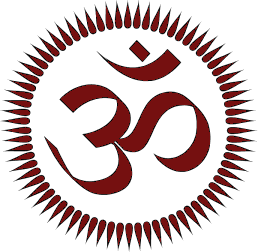If you see this website on a mobile device you might want to put your phone in landscape mode for the best experience.
Mantras
In our daily Mysore classes Katia and I chant the Mantras and Shlokas we learned with our teacher Prof. MV Varadarajan, Mysore. Vedic recitation forms a large part of our daily practice and the benefits of chanting (or even simply listening) are considerable. Once the student has largely committed the passages to memory it is possible to get the feeling that the text is chanting you. Vedic recitation is powerful meditation, great for improving concentration and effective mind medicine.
We have recorded some essential mantras that we use in our chanting classes.
Ganesha Stotram
Then there is this very popular mantra to the Elephant headed Hindu deity Ganesh who is the lord of obstacles. We chant to Ganesh to clear blocked energy and make our journey smooth and fruitful.
Shuklaambara Dharam Vishnum Shashi Varnam Chatur Bhujam
Prasanna Vadanam Dhyaayet Sarva Vighnopashaantaye (Vighna Upashaantaye)
Meaning:
O Lord, he whose dress is the wide white sky, who is all pervading, whose arms are spread to all four sides
One with the blissful face, We meditate on you, nullify all troubles
Alternate Meaning:
O Lord, who is wearing White colored clothes, Who is all pervading, who has four hands
Who has a peaceful, joyous face we meditate on you, remove all the obstacles.
Shanti Mantra – Taitirya Upanishad – Saha Nau-Avatu
From the Taitirya Upanishad, a mantra to sanctify the relationship between teacher and student.
Om Saha Nau-Avatu |
Saha Nau Bhunaktu |
Saha Viiryam Karavaavahai |
Tejasvi Nau-Adhiitam-Astu Maa Vidvissaavahai |
Om Shaantih Shaantih Shaantih ||
Meaning
Aum! May He protect us both together; may He nourish us both together;
May we work conjointly with great energy,
May our study be vigorous and effective;
May we not mutually dispute (or may we not hate any).
Aum! Let there be peace in me!
Let there be peace in my environment!
Let there be peace in the forces that act on me!
Mahamrityunjaya Mantra
The Mahamrityunjaya Mantra reads:
oṃ tryambakaṃ yajāmahe sugandhiṃ puṣṭi-vardhanam
urvārukam iva bandhanān mṛtyor mukṣīya mā ‘mṛtāt
Meaning
‘We worship the three-eyed One (Lord Shiva) who is fragrant and who nourishes all beings; may He liberate me from death, for the sake of Immortality, even as the cucumber is severed from its bondage (of the creeper.’
Significance of Mahamrityunjaya Mantra
Mahamrityunjaya mantra is also known as the Triyambaka Mantra. According to many, chanting the mantra releases a string of vibrations that realigns the physical body ensuring maintenance and restoration of good health.
In fact, Mahamrityunjaya Mantra is a verse from the Rig Veda and is considered to be the most powerful Shiva Mantra. It bestows longevity, wards off calamities and prevents untimely death. It also removes fears and heals holistically. This eternal mantra is also a part of the Yajurveda.
Gayatri Mantra
Om Bhuur-Bhuvah Svah
Tat-Savitur-Varennyam
Bhargo Devasya Dhiimahi
Dhiyo Yo Nah Pracodayaat ||
Meaning
1: Om, Pervading the Bhu Loka (Earth, Consciousness of the Physical Plane), Bhuvar Loka (Antariksha, The Intermediate Space, Consciousness of Prana) and Swar Loka (Sky, Heaven, Consciousness of the Divine Mind),
2: That Savitur (Savitri, Divine Essence of the Sun) which is the most Adorable,
3: I Meditate on that Divine Effulgence,
4: May that Awaken our Intelligence (Spiritual Consciousness).
Shanti Mantra – Rig veda – Bhadram Karnnebhih
Om Bhadram Karnnebhih Shrnnuyaama Devaah |
Bhadram Pashyema-Akssabhir-Yajatraah |
Sthirair-Anggais-Tussttuvaamsas-Tanuubhih |
Vyashema Deva-Hitam Yad-Aayuh |
Svasti Na Indro Vrddha-Shravaah |
Svasti Nah Puussaa Vishva-Vedaah |
Svasti Nas-Taarkssyo Arisstta-Nemih |
Svasti No Vrhaspatir-Dadhaatu ||
Om Shaantih Shaantih Shaantih ||
Meaning
1: O Devas, May we Hear with our Ears what is Auspicious,
2: O (Devas who are) Worthy of Worship, May we See with our Eyes what is Auspicious,
3: With (Sense) Organs Steady and Body Praying (due to Hearing and Seeing the Auspicious) …
4: … May we Attain (i.e. Spend) the Lifespan allotted by the Devas (thus finding fulfillment in our lives).
5: May Indra whose Glory is Great, bestow Well-Being on Us,
6: May Pushan who is All-Knowing, bestow Well-Being on Us,
7: May Tarkshaya who is a Circle of Protection, bestow Well-Being on Us,
8: May Brihaspati (also) bestow Well-Being on Us,
9: Om, Peace, Peace, Peace.
Shanti mantra – Brihadaranyaka Upanishads – Asato Maa
Om Asato Maa Sad-Gamaya |
Tamaso Maa Jyotir-Gamaya |
Mrtyor-Maa Amrtam Gamaya |
Om Shaantih Shaantih Shaantih ||
Meaning
1: Om, (O Lord) Keep me not in (the Phenomenal World of) Unreality, but make me go towards the Reality (of Eternal Self),
2: Keep me not in (the Ignorant State of) Darkness, but make me go towards the Light (of Spiritual Knowledge),
3: Keep me not in (the World of) Mortality, but make me go towards the World of Immortality (of Self-Realization),
4: Om, Peace, Peace, Peace.
Shanti mantra – Taittiriya Upanishad – Sham No Mitrah
Om Sham No Mitrah Sham Varunnah |
Sham No Bhavatv[u]-Aryamaa |
Sham No Indro Brhaspatih |
Sham No Vissnnur-Urukramah |
Namo Brahmanne |
Namaste Vaayo |
Tvam-Eva Pratyakssam Brahmaasi |
Tvaam-Eva Pratyakssam Brahma Vadissyaami |
Rrtam Vadissyaami |
Satyam Vadissyaami |
Tan -Maam-Avatu |
Tad-Vaktaaram-Avatu |
Avatu Maam |
Avatu Vaktaaram ||
Om Shaantih Shaantih Shaantih ||
Meaning
1: Om, May Mitra be Propitious towards Us; May Varuna be Propitious (towards Us),
2: May Aryaman be Propitious towards Us,
3: May Indra and Brihaspati be Propitious towards Us,
4: May Vishnu who makes Wide Strides be Propitious towards Us,
5: Salutations to Brahman (the Universal Soul),
6: Salutations to You, O Vayu (the Breath or Life-Force),
7: You Indeed are the Perceptible Brahman (i.e. the Breath or Life-Force is indeed the Perceptible Brahman or the Shakti of Brahman),
8: I Proclaim that You Indeed are the Perceptible Brahman,
9: I Proclaim the Divine Order,
10: I Proclaim the Truth,
Ganesh mantra – Rig Veda – Gannaanaam Tvaa Ganna-Patim
Gannaanaam Tvaa Ganna-Patim Havaamahe
Kavim Kaviinaam-Upama-Shravastamam |
Jyessttha-Raajam Brahmannaam Brahmannaspata
Aa Nah Shrnnvan-Uutibhih Siida Saadanam ||
Meaning
(This Mantra of Rig Veda 2.23.1 is addressed to Brihaspati / Brahmanaspati)
1: Among the Ganas (Group of Prayers), to You Who are the Ganapati (Lord of Prayers), we Offer our Sacrificial Oblations,
2: You are the Wisdom of the Wise and Uppermost in Glory,
3: You are the foremost King of the Prayers, presiding as the Lord of the Prayers (Brahmanaspati),
4: Please come to us by Listening to our Invocation and be Present in the Seat of this Sacred Sacrificial Altar (to charge our Prayers with Your Power and Wisdom).
Om Gam Ganapataye Namaha
Om Gam Ganapataye Namaha
Meaning
Let’s break down what each part of this mantra represents:
Om: Om, or aum, is the sound that represents the birth of the universe and the connection between all living beings.
Gam: Gam is the sound of the root chakra and it’s thought to awaken energy at the base of the spine. According to ancient yogic wisdom, Ganesh resides in the first chakra, the root chakra, or Muladhara. Mula means “original,” and adhara means “foundation,” so the Muladhara chakra forms the root that supports our energy and action.
Ganapataye: Another name for Ganesh, the deity who removes obstacles.
Namaha: A salutation, similar to namaste.
NOT PART OF THE CHANTING CLASS
Sri Rudram / Chamakam
I have managed to record all of Sri Rudram and Chamakam in one sitting. These are the principal prayers to Lord Shiva the Hindu God of destruction. Singing Rudram and Chamakam is praying for benevolence and blessings from the creator and destroyer, Shiva who is essentially pure consciousness.











